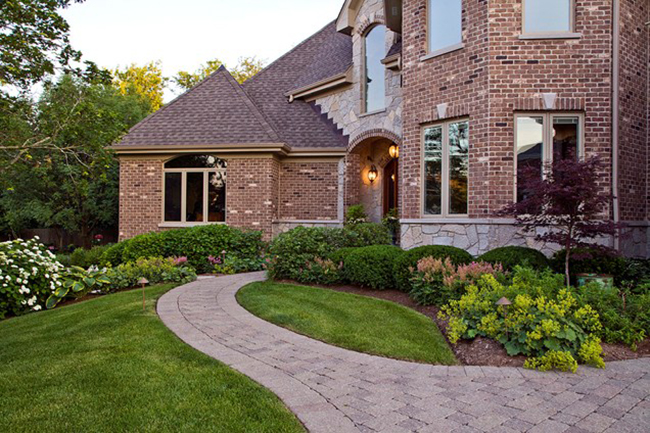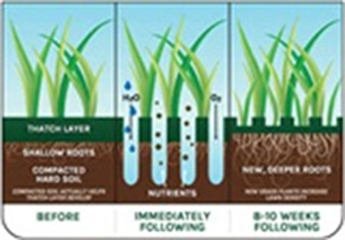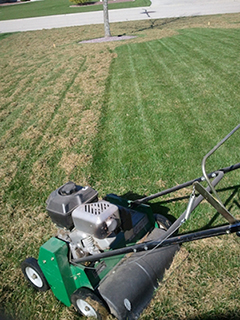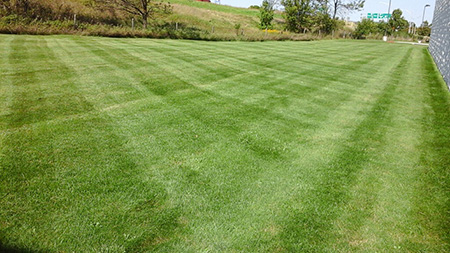
Premier Outdoor Maintenance Services for Residential & Commercial Properties
Lawn Maintenance Program for business or residential in the Sheboygan Area

Lawn Core Aeration
Question: When is it a good time to aerate my lawn and how often do I need to have it done?
Answer: The best time to aerate your lawn is usually in middle of spring or in the late fall.
If I had to choose only one time of year to aerate my lawn, I would do it in the spring. This is because aerating lawn in the spring will prepare it for summer and this is when you will enjoy your lawn the most! After you aerate, you can also over seed and put down starter fertilizer. Not only that, but when people have a lot of clay in their soil, the soil will expand in the summertime. Aerating with a core aerator allows the soil room to expand without compacting the roots. Also, springtime aeration helps develop deeper roots and a thicker turf. A deeper root system also helps in the summer when there is less water. You get the greatest benefit out of your lawn when you aerate in the spring.
We recommend you should aerate a lawn every other year. Aerating is a great way to save water. Grass with deeper roots allows you to water less often and still have a green lawn in the summer.
If you have bad soil, you should aerate at least once a year for the first five years you own a home. It is very effective to also fertilize and over seed right after aerating. In the spring, applying starter fertilizer after aeration is a great way to strengthen the root system and encourage root development. After a lawn is established, most experts still recommend that you aerate once every three years.


Lawn Dethatching
It's important to choose the right time of year to dethatch, depending upon the type of grass you have and your climate.
Dethatching is tough on a lawn so do it when the lawn will have the best chance to recover. Don't dethatch if you're in a drought or a heat wave. Ideally, there should be about 45 days of good growing conditions after the dethatching process. Generally, late spring and early fall are the best times.
Dethatching can leave your lawn looking like a disaster area, especially if the blades dig into the soil. If your lawn produces a lot of thatch, dethatch annually, so that it's not such a big job. If the thatch is no more than a half-inch (1.27 centimeters) deep, you can probably get by with every other year. If it's as much as 1.5 inches (3.81 centimeters) deep, you might need to dethatch in spring and fall.
Mowing regularly, and cutting at short intervals of growth will also help to prevent thatch build up!!!
Lawn Cutting
We have over 12 years combined experience and knowledge on staff to ensure that our residential, commercial and municipal clients' lawns are cut at appropriate heights based on time of the season and weather factors.  During dry times of the year we cut our lawns longer to prevent the ground drying out, we look out for the lawn and the customer's pocket book too! We don't just mow lawns in heat of the summer day when it's drying & browning out. We will site visit and determine if it needs services or if it can wait.
During dry times of the year we cut our lawns longer to prevent the ground drying out, we look out for the lawn and the customer's pocket book too! We don't just mow lawns in heat of the summer day when it's drying & browning out. We will site visit and determine if it needs services or if it can wait.
Our services include cutting, trimming and blowing walkways. We also watch for turf diseases and insects and provide early diagnosis and treatment for problem areas.
We offer per time mowing or Seasonal contracts. We can also do complete packages including Fertilizing, Spring and Fall Clean-ups & Pruning.
Over-Seeding
Give your lawn thicker growth, better color, and greater resistance to disease and drought!
What is Overseeding?
Overseeding is the planting of grass seed directly into existing turf, without tearing up the turf, or the soil. It's an easy way to fill in bare spots, improve the density of turf, establish improved grass varieties and enhance your lawn's color. If a lawn looks old, or just worn out, if it needs growing amounts of water and fertilizer to thrive, or is disease or insect prone, it's a perfect candidate for overseeding.
Many older lawns were established with common type turf grasses not suited for the needs of today's homeowner. They're often more disease and insect prone, requiring more fertilizer and water.
Overseeding newer turfgrass varieties into an older lawn can help it better withstand insects, disease, drought, shady conditions and heavy traffic. The investment in overseeding pays off by reducing the amount of fertilizer, water and pesticides required. Most importantly, a renovated lawn stays greener and looks thicker and healthier!
How Slit-Seeding Works
Slit-seeders have verticutting blades that cut through the thatch layer and open up a slit or miniature furrow in the soil. The depth of the slit or miniature furrow is based on the type of grass seed used. A general rule of thumb is to go no deeper than half the length of the grass seed husk. The slit-seeding unit has concave disk blades that follow in the slits and keep them open while the seed is dropped; it ensures the seed gets into the soil where it can germinate.
Slit-seeding generally takes less seed than broadcast seeding, because most of the seed gets into the soil so it can germinate. More seed-to-soil contact means a higher germination rate and a better stand of new grass.
When is the BEST time to overseed?
Late summer or early fall is the best time to overseed lawns. Soil and atmospheric temperatures are most favorable for optimum seed germination and growth. With adequate moisture, fertilizer and sunlight, the new seedlings will be well established before cooler fall weather sets in. Also, weed competition is less of a factor at this time, giving the grass seedlings a better environment to grow and develop.
Spring overseeding risks the chance of weather-related problems (heavy spring rains, unexpected high temperatures) and weed competition. Also, spring seeding may interfere with the application of pre-emergent crabgrass or broadleaf weed killers; concurrent application of seed and herbicides is generally not recommended because the herbicides may cause poor seedling establishment. It is best to delay herbicide treatment 4-6 weeks after new grass seed germinates. If you choose to overseed in the spring, be sure to follow proper seeding and treatment practices.
Midsummer overseeding faces greater chances of disease, heat and drought stress, and weed competition. Proper weed control and adequate irrigation are musts if overseeding is attempted in midsummer.
Dormant overseeding involves seeding in late fall or early winter, after soil temperatures are low enough to prevent seed germination.
Success usually requires good snow cover during the winter, to prevent wind or water erosion and ensure germination doesn’t begin too early. This method is sometimes preferred over spring seeding, especially in northern areas, because you don’t have to wait for soil or moisture conditions to improve before overseeding

